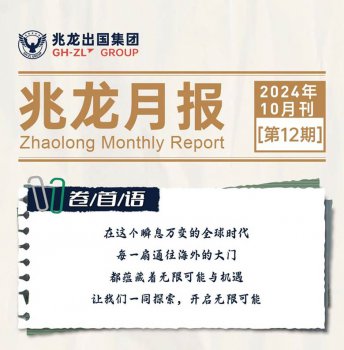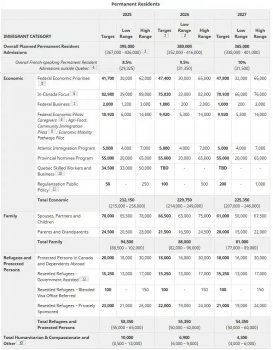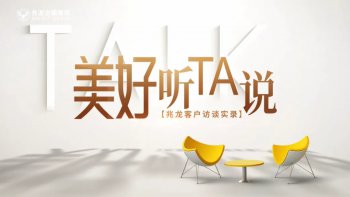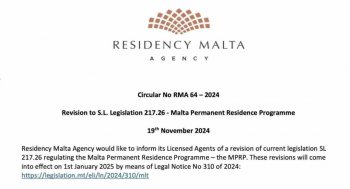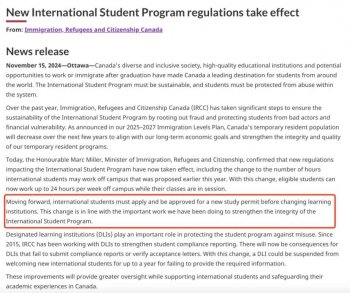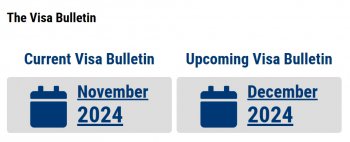移民局B表同步國務院2015-05-15
更新時間:2020-01-21EB-5投資人翹首以盼的美國移民局B表今天終于公布,中國大陸EB-5的收件截止日期為2015年5月15日,與美國國務院同步。見下表:
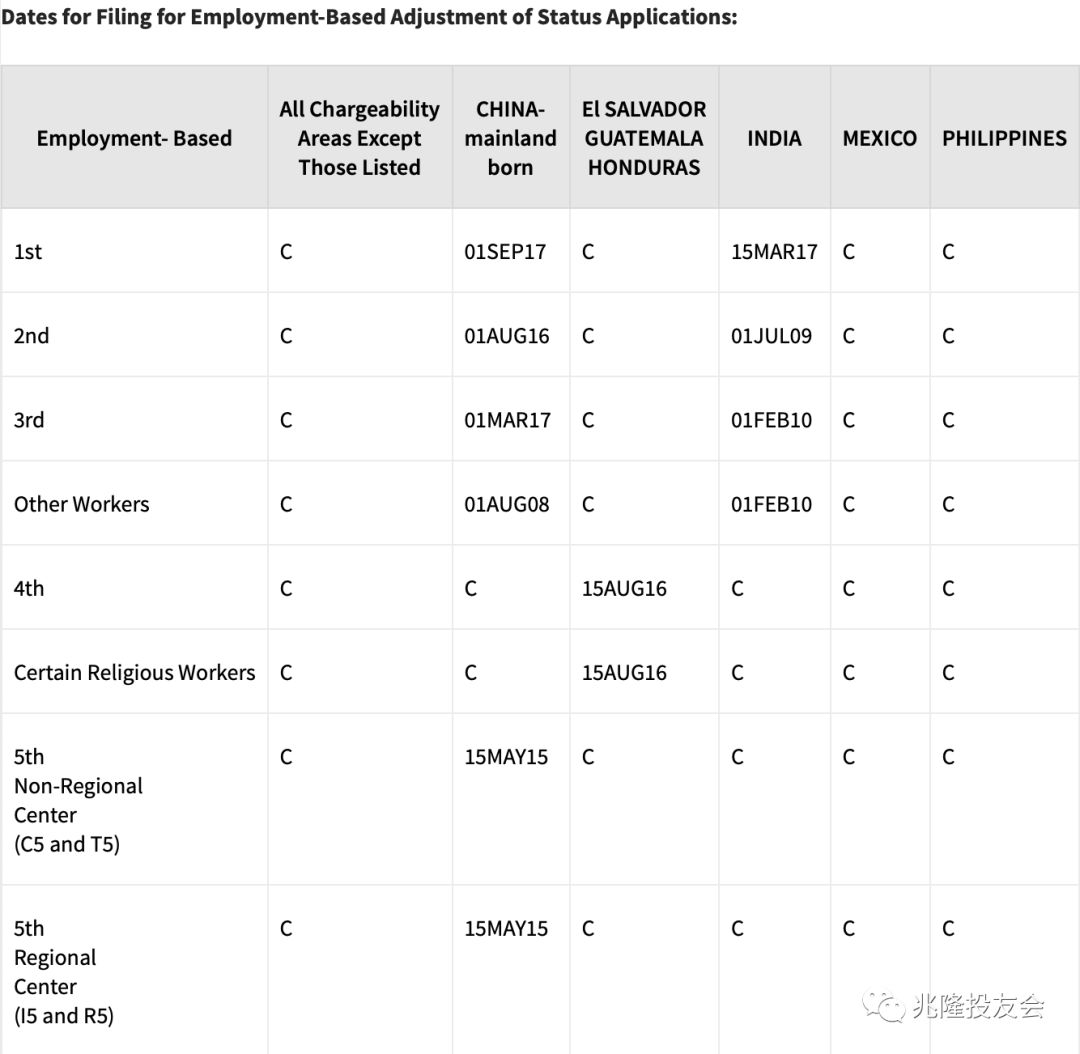
美國移民局B表同步國務院B表,為什么是一個重大的利好信號:
B表相當于排期的遠期指數,A表相當于排期的當前指數。移民局同步國務院,將B表收件截止日定在2015年5月15日,說明即使是相對保守的移民局,也對排期的遠期前景展現樂觀。
國務院與移民局B表中越南、印度等國家均沒有排期,說明這些國家對我們一年后的遠期影響不大。
又一個中國EB-5投資人排期最黑暗的時期已經過去的重要信號。
同時,我們也要以平常心對待B表的進步,我們估計B表大幅進步于A表,應當是一個長期持續的現象,不只是短期一兩個月的暫時現象,所以投資人不必為搶時間而著急。可以預見,如果中介公司們象以前一樣大肆鼓動投資人提前登錄美國遞交485,不排除美國移民局再次把B表收件截止日期縮短。所以,還是讓我們保持平常心,順勢而為,如果確實已經在美國,并且符合在美國境內遞件485的條件,就通過律師盡快準備。如果不在美國,不要勉強為之。
下面附上兆隆投友會EB-5主任律師Yevgeny Samokhleb的B表指導文章。
Understanding the NVC and USCIS Visa Bulletins
NVC和USCIS移民排期公告解讀
By 作者: Yevgeny Samokhleb律師
Every month the National Visa Center (NVC) and USCIS publish a Visa Bulletin that announces which priority dates are eligible for immigrant visa processing. Priority dates are based on the date that a petition for an immigration benefit was initially submitted. Because there are more applicants for immigration every year than there are available visas, approved immigrants must wait in a visa queue until their priority date becomes available.
美國國家簽證中心(NVC)和移民局(USCIS)每月都會發布移民排期公告,公布移民簽證辦理的優先日期進度。優先日期,即申請人最初遞交移民申請的日期。因為每年的移民申請人數多于可簽發的簽證數量,所以獲批的移民申請人必須排隊等待簽證名額,直到排期前進到他們的優先日期。
The monthly Visa Bulletin consists of two charts. Chart A is called “Final Action Dates,” and shows priority dates for which a visa is available. Chart B is called “Dates for Filing,” and shows priority dates for which paperwork may be preliminarily submitted. Priority dates become available for processing per Chart B first – several months or even years before the actual visas become available per Chart A. The purpose of Chart B is to enable immigrants to prepare and file their necessary paperwork in advance. Subsequently, when their priority date become current per Chart A, they will only need to attend a visa interview to complete their case.
月度排期公告包括兩個表格。表A是“綠卡批準排期”,顯示可簽發簽證的優先日期;表B是“遞件排期”,顯示可遞交申請文件的最早日期。表B排期進度快于表A排期數月甚至數年不等。表B的目的是讓移民申請人可以提前準備遞交必要的文件。這樣,當表A顯示排期前進到申請人優先日的時候,申請人只需去面簽即可完成移民申請。
NVC publishes its Visa Bulletin around the middle of each month, and USCIS publishes its own within a week thereafter. For immigrants going through NVC consular processing, Chart B on the NVC Visa Bulletin will inform them of eligibility to file the DS-260 Immigrant Visa Application. For immigrants who are already in the United States on a temporary visa, Chart B on the USCIS Visa Bulletin will inform them of eligibility to file an I-485 Application for Adjustment of Status.
NVC大概每月中旬公布排期,USCIS則在其后一周內公布。對于正在辦理NVC領事手續的申請人,NVC排期表B將告知他們可遞交DS-260移民簽證申請的日期。對于已經持臨時簽證入境美國的申請人, USCIS排期表B將告知他們可遞交I-485身份調整申請的日期。
Though the two Visa Bulletins are related, they are not identical. Chart A visa availability dates will always be the same for both NVC and USCIS. However, Chart B filing eligibility may vary. Chart B is based on anticipated application demand and the processing capacity of each agency. Due to long processing backlogs, USCIS often disallows I-485 filings per Chart B or restricts them to only certain immigration categories. Thus, it is considered a privilege to be able to file an I-485 Application for Adjustment of Status based on Chart B.
兩個排期表雖有關聯,但是并不完全相同。表A上NVC和USCIS顯示的簽證可簽發日期是始終一樣的,而表B顯示的可遞交日期卻可能不同。表B的排期按預期申請需求以及每個機構的審理能力而定。由于處理積壓申請的時間長,USCIS通常不允許根據表B遞交I-485,或者對其移民申請類別進行限制。因此,能夠基于表B遞交I-485申請身份調整被視為一種優待。
It is important to note that those who may be eligible to file an I-485 Application in the United States should not always immediately do so. For those who arrived in the U.S. on a temporary nonimmigrant visa, an I-485 should usually not be filed until at least 90 days after their date of entry. Filing an I-485 sooner creates a possible risk of being found of having misrepresented their entry intent in a way that’s inconsistent with the intended purpose of such nonimmigrant visas. However, those who are in the U.S. in H-1B or L-1 status are exempt the 90-day rule, and may file an I-485 application at any time.
需要注意的是,符合在美國遞交I-485的申請人并非都應立即遞交申請。對于已經通過臨時非移民簽證入境美國的申請人,通常應在入境至少90天后再遞交I-485申請。提早遞交申請可能會導致移民局懷疑申請人的入境意圖與非移民簽證的預期意圖不一致。但是,如果申請人在美國持有H-1B簽證或L-1簽證,則不用考慮這一點,可隨時遞交I-485申請。
For beneficiaries of an approved immigration petition, NVC and USCIS each provides a route to the same Green Card, but the process is different. Both require similar paperwork, which largely consists of personal biographic information and documents such as passports, birth certificates, marriage certificates, etc. However, each one also has some advantages and disadvantages.
對于移民申請獲批的受益人,NVC和USCIS都提供獲得相同綠卡的途徑,但審理過程不同。兩者要求的文件類似,基本上包括個人履歷信息及護照、出生證、結婚證等文件。但是兩者各有其優缺點。
Filing an I-485 with USCIS grants applicants immediate lawful status in the United States, and supersedes their existing temporary visa. Within approximately a month of filing, applicants will receive an appointment for fingerprinting at a local USCIS office. Applicants also typically file a simultaneous Form I-765 and Form I-131, which upon approval respectively grant the right to work and travel until a Green Card is issued. Without an I-131 travel document, I-485 applicants may not leave the U.S. before they obtain a Green Card. Thus, it is always advisable to apply for a travel document – especially for those who file an early I-485 Application per Chart B. With an I-131 Application for Advance Parole, applicants may leave the U.S. after the travel document is approved. Both the I-765 and I-131 are typically approved within 3-5 months, and applicants are issued employment and travel documents that are usually valid for 2 years and can be renewed thereafter if the Green Card application still remains pending.
向USCIS遞交I-485的申請人可直接獲得在美國的合法身份,并取代他們現有的臨時簽證。遞交申請后一個月左右,申請人即可收到USCIS當地辦事處的打指紋預約。通常,申請人還會同時遞交I-765和I-131表格,表格獲批后,申請人在綠卡尚未發放期間可以出入美國,在美國工作。如果沒有I-131回美證,I-485申請人在獲得綠卡前就不得離開美國。因此,我們一般建議申請回美證,尤其是那些按照表B提早遞交I-485的申請人。I-131回美證獲批后,申請人便可離開美國。I-765和I-131申請獲批通常需要3至5個月,證件有效期通常為2年,到期后如果綠卡還未發放,可申請續簽。
Obtaining a Green Card through the NVC process is generally less expensive ($565 vs $1,225 per family member) and much quicker (a few months vs 1-2 years) than with USCIS, but does not provide the security and comfort of residing in the U.S. during the application process. It should be noted that unless derivative family members (spouse and children) file simultaneously and together with the primary applicant, they will have to wait until the primary applicant receives his or her Green Card. Thus, if the petitioner lives in China while his or her child is a student residing in the U.S., the child may not file a I-485 application separately from the parent petitioner unless the parent first completes the NVC visa process and enters the United States. Therefore, once the time for filing arrives, immigrant families will have to weigh their available options and determine the one most suitable for them.
相比于USCIS,通過NVC審理獲取綠卡通常花費更少(每個家庭成員565美元,USCIS為1225美元),速度更快(幾個月即可,而USCIS為1至2年),但是不允許申請人申請期間在美國居住。另外還有一點,如果主申請人的家庭成員(配偶和子女)不是和主申請人一起同時遞交申請的話,其成員必須等主申請人獲得綠卡。因此,如果申請人在中國居住,而子女在美國就讀的話,其子女不得單獨遞交I-485申請,除非父母已經完成NVC簽證辦理并入境美國。所以,一旦到了遞交時間,移民家庭必須權衡分析,選擇最合適的遞交方式。
Yevgeny Samokhleb律師
版權聲明:本文由兆龍移民獨家精選,未經授權,禁止一切同行與媒體轉載。歡迎個人轉發分享至朋友圈。
標簽:
上一篇:NVC檔案號變更答疑 下一篇:漲價后EB5排期走向


